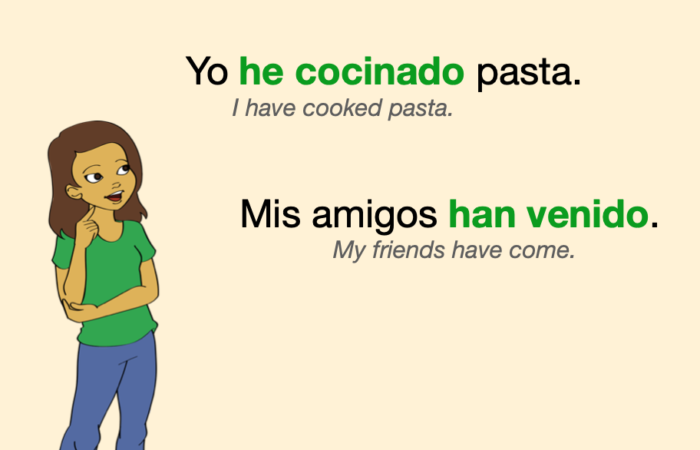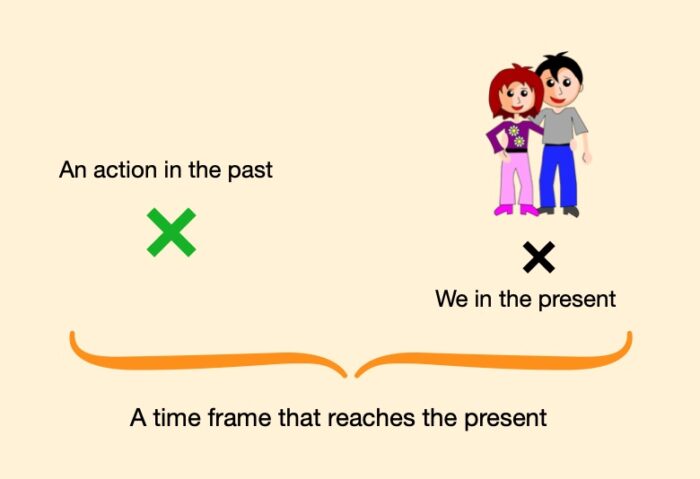Welcome 😊 to our grammar lesson on the Spanish Present Perfect (“Pretérito Perfecto Compuesto” or “Antepresente de Indicativo”).
We use the Present Perfect to talk about past actions, usually recent ones.

By the end of this lesson, you will be able to conjugate verbs in Present Perfect and use them in sentences.
You will also find a Quiz and Exercises to practice.
Contents
Conjugation of verbs in Present Perfect
The formula to form the Present Perfect consists of 2 words:
- First, the verb haber in Present Tense: he, has, ha, hemos, habéis, han.
- Second, the Past Participle of the verb expressing the action. The Past Participle is the same for all persons.
Using that formula, here are some verbs fully conjugated in Present Perfect. These particular verbs have a regular Past Participle:
| Person | jugar to play | beber to drink | sentir to feel |
|---|---|---|---|
| yo | he jugado | he bebido | he sentido |
| tú | has jugado | has bebido | has sentido |
| él | ha jugado | ha bebido | ha sentido |
| nosotros | hemos jugado | hemos bebido | hemos sentido |
| vosotros | habéis jugado | habéis bebido | habéis sentido |
| ellos | han jugado | han bebido | han sentido |
And here are a couple more verbs conjugated in Present Perfect. These are verbs with an irregular Past Participle:
| Person | hacer to do | ver to see |
|---|---|---|
| yo | he hecho | he visto |
| tú | has hecho | has visto |
| él | ha hecho | ha visto |
| nosotros | hemos hecho | hemos visto |
| vosotros | habéis hecho | habéis visto |
| ellos | han hecho | han visto |
Remember…
The Past Participle of regular verbs in -ar ends in -ado.
The Past Participle of regular verbs in -er and -ir ends in -ido.
Some verbs have an irregular Past Participle. The most important irregular ones are:
hacer → hecho
decir → dicho
ver → visto
escribir → escrito
romper → roto
poner → puesto
volver → vuelto
resolver → resuelto
satisfacer → satisfecho
descubrir → descubierto
morir → muerto
Click here to learn more about the Past Participle
Use of the Present Perfect
We use the Present Perfect to talk about past actions. But… there are several tenses in Spanish to talk about past actions! So, when exactly do we use the Present Perfect?
We use it if one of the the following things is true:
- The sentence mentions a time frame that reaches the present.
- The sentence doesn’t mention any time frame, but the action is recent.
Let’s study each case in detail:
1. The sentence mentions a time frame that reaches the present
We want to express an action in the past, mentioning a a time frame that reaches the present.

For example, consider the following sentence in English: “I played soccer today”. The action (“I played soccer”) is in the past, but “today” is a time frame that reaches the present: we are still in “today”:
Yo he jugado al fútbol hoy.
I played soccer today.
Another example: “We have done many things this year”. The actions are in the past, but “this year” reaches the present:
Nosotros hemos hecho muchas cosas este año.
We have done many things this year.
One more example: “I have won many competitions in my life”. The actions are in the past, but I am still “in my life”:
He ganado muchas competiciones en mi vida.
I have won many competitions in my life.
2. The sentence doesn’t mention any time frame, but the action is recent
For example, in the following sentences, it is understood that the actions are recent:
¿Qué habéis hecho vosotros?
What have you guys done?Yo he comido pasta.
I have eaten pasta.Mis amigos han visto una película.
My friends have watched a movie.¿No has comprado el regalo?
Didn’t you buy the gift?
Placing the word “no”: always before the whole verb
To form a negative sentence, we place no before the two words that form the Present Perfect, never in between:
No he cocinado.
I have not cooked.Ellos no han dicho nada.
They have not said anything.
Keywords with the Present Perfect
The following keywords tend to work well in sentences with the Present Perfect:
- hoy = today
- esta semana = this week
- este mes = this month
- este año = this year
- últimamente = lately
- hasta ahora = until now
- desde entonces = since then
- en mi vida = in my life
- siempre = always
- nunca = never
Notice that they all express time frames that reach the present.
Example sentences:
Yo he conocido a mucha gente en mi vida.
I have met a lot of people in my life.Tú has empezado un curso de español este mes.
You have started a Spanish course this month.Paula siempre ha tenido la misma opinión.
Paula has always had the same opinion.Nosotros hemos cambiado mucho desde entonces.
We have changed a lot since then.Mis abuelos han venido hoy.
My grandparents have come today.
Other useful keywords: “ya”, “aún no”, “todavía no”
Sometimes we find the words ya, aún no and todavía no near the Present Perfect.
Their meanings are:
- ya = already
- aún no = not yet
- todavía no = not yet (same meaning as “aún no”)
We usually place these keywords before the verb:
Antonio ya ha estudiado la lección
Antonio has already studied the lesson.Nosotros aún no hemos preparado el desayuno.
We have not prepared breakfast yet.Los teléfonos todavía no han sonado.
The phones have not rung yet.
Practice
Let’s practice the Present Perfect with a quiz and some exercises!
Quiz
Exercise 1
Read the following sentences in English and pay attention to the time frames they mention.
Which sentences could we translate to Spanish using the Present Perfect?
1) I’ve gone to the circus today.
2) I haven’t traveled this year.
3) Last year we went to Kenya.
4) I’ve met many people in my life.
5) We talked three months ago.
6) We have spoken.
Solution: The sentences we could translate using the Present Perfect are numbers 1, 2, 4 and 6.
Numbers 1, 2 and 4: because they mention time frames that reach the present.
Number 6: because it doesn’t mention any time frame, but it is understood that the action is recent.
Exercise 2
Conjugate the following verbs in Present Perfect. Click on the gray spaces to see the solutions.
(these are verbs with a regular Past Participle)
1) yo he nadado (nadar)
2) tú has bebido (beber)
3) él ha vivido (vivir)
4) nosotros hemos salido (salir)
5) vosotros habéis entrado (entrar)
6) ellos han prometido (prometer)
Exercise 3
In the following sentences, fill the gaps using the Present Perfect of the verbs in brackets.
(these are verbs with a regular Past Participle)
1) Tú has mejorado mucho últimamente. (mejorar)
You have improved a lot lately.
2) Gonzalo no ha dormido la siesta hoy. (dormir)
Gonzalo didn’t take a nap today.
3) Laura y sus amigos han comprado las entradas. (comprar)
Laura and her friends have bought the tickets.
4) Yo he comido la carne que vosotros habéis cocinado . (comer, cocinar)
I have eaten the meat that you guys have cooked.
5) Nosotras hemos nadado dos horas. (nadar)
We have swam for two hours.
Exercise 4
Conjugate the following verbs in Present Perfect.
(these are verbs with an irregular Past Participle)
1) yo he vuelto (volver)
2) tú has visto (ver)
3) él ha dicho (decir)
4) nosotros hemos resuelto (resolver)
5) vosotros habéis satisfecho (satisfacer)
6) ellos han puesto (poner)
Exercise 5
In the following sentences, fill the gaps using the Present Perfect of the verbs in brackets.
(these are verbs with an irregular Past Participle)
1) Nosotros no hemos roto el vaso. (romper)
We haven’t broken the glass.
2) ¿Qué han hecho hoy Carmen y Marcos? (hacer)
What have Carmen and Marcos done today?
3) Tú has escrito una carta muy bonita. (escribir)
You have written a very nice letter.
4) Yo he descubierto cosas importantes este año. (descubrir)
I have discovered important things this year.
5) ¿Qué habéis dicho vosotros? (decir)
What have you guys said?
6) Mi padre ha resuelto el problema. (resolver)
Mi father has solved the problem.








